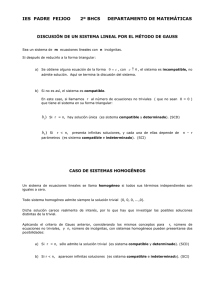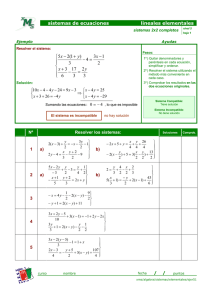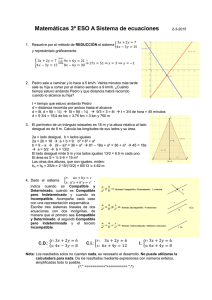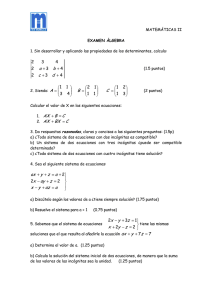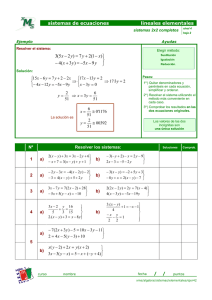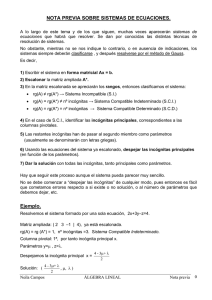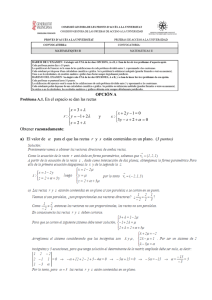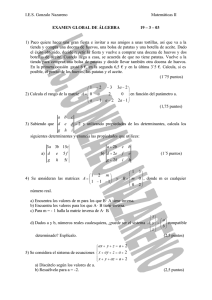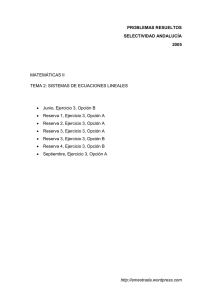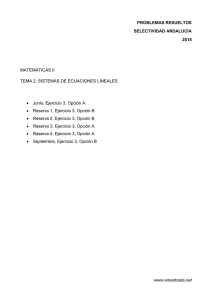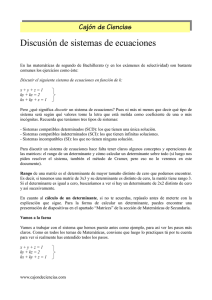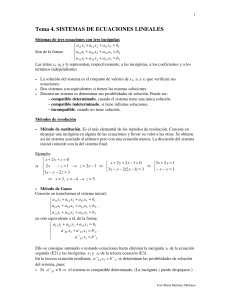GLOBAL ÁLGEBRA 2 compatible.
Anuncio
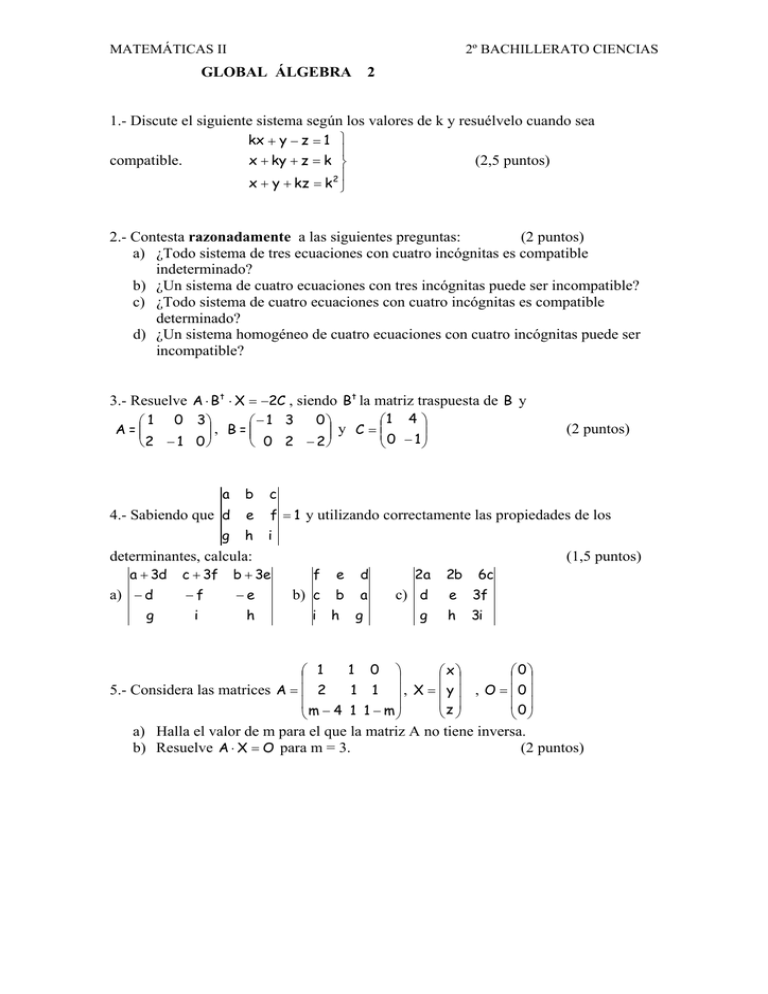
MATEMÁTICAS II 2º BACHILLERATO CIENCIAS GLOBAL ÁLGEBRA 2 1.- Discute el siguiente sistema según los valores de k y resuélvelo cuando sea kx + y − z = 1 ⎫ ⎪ x + ky + z = k ⎬ ⎪ x + y + kz = k 2 ⎭ compatible. (2,5 puntos) 2.- Contesta razonadamente a las siguientes preguntas: (2 puntos) a) ¿Todo sistema de tres ecuaciones con cuatro incógnitas es compatible indeterminado? b) ¿Un sistema de cuatro ecuaciones con tres incógnitas puede ser incompatible? c) ¿Todo sistema de cuatro ecuaciones con cuatro incógnitas es compatible determinado? d) ¿Un sistema homogéneo de cuatro ecuaciones con cuatro incógnitas puede ser incompatible? 3.- Resuelve A ⋅ Bt ⋅ X = −2C , siendo Bt la matriz traspuesta de B y ⎛1 4 ⎞ 0⎞ ⎛ 1 0 3⎞ ⎛−1 3 ⎟ ⎟⎟ , B = ⎜⎜ ⎟⎟ y C = ⎜⎜ A = ⎜⎜ ⎟ ⎝2 − 1 0 ⎠ ⎝ 0 2 − 2⎠ ⎝ 0 − 1⎠ (2 puntos) a b c 4.- Sabiendo que d e f = 1 y utilizando correctamente las propiedades de los g h i determinantes, calcula: a + 3d a) − d g c + 3f b + 3e −f −e i h (1,5 puntos) e d 2a b) c b a c) d e 3f g h 3i f i h g 2b 6c 1 0 ⎞ ⎛ 1 ⎛0⎞ ⎛x⎞ ⎜ ⎟ ⎜ ⎟ ⎜ ⎟ 1 1 ⎟ , X = ⎜ y ⎟ , O = ⎜0⎟ 5.- Considera las matrices A = ⎜ 2 ⎜ ⎟ ⎜ ⎟ ⎜z ⎟ ⎝ ⎠ ⎝0⎠ ⎝m − 4 1 1 − m⎠ a) Halla el valor de m para el que la matriz A no tiene inversa. b) Resuelve A ⋅ X = O para m = 3. (2 puntos) MATEMÁTICAS II 2º BACHILLERATO CIENCIAS SOLUCIONES ⎛k 1 − 1 1 ⎞ kx + y − z = 1 ⎫ ⎛k 1 − 1⎞ ⎜ ⎟ ⎜ ⎟ ⎪ 1.- x + ky + z = k ⎬ A = ⎜ 1 k 1 ⎟ A'= ⎜ 1 k 1 k ⎟ ⎜ ⎟ ⎜ ⎟ ⎪ ⎜1 1 k k2 ⎟ x + y + kz = k 2 ⎭ ⎝1 1 k ⎠ ⎝ ⎠ en principio, en A no tenemos ningún menor de orden 2 distinto de cero, hacemos el k=0 determinante de A: A = k 3 + 1 − 1 + k − k − k = k 3 − k = 0 ⇒ k(k 2 − 1) = 0 ⇒ k = 1 k = −1 0 1 1 Para k = 0 → r(A) = 2 1 0 0 ≠ 0 → r(A') = 3 INCOMPATIBLE 1 1 0 Para k = 1 → r(A) = 2 → r(A') = 2 (2ª y 3ª filas iguales) C. INDETERMINADO Nos quedamos con las dos primeras ecuaciones, ya que → 1 −1 1 1 =2≠0 ⎧x = t ⎪ ⎨y = 1 − t ⎪z = 0 ⎩ Para k = −1 → r(A) = 2 → r(A') = 2 (1ª y 2ª filas proporcionales) C. INDETERMINADO, nos quedamos con la 2ª y 3ª ecuaciones: ⎧x = 0 x − y + z = −1⎫ x − y = −1 − t ⎫ ⎪ ⎬ →z =t→ ⎬ ⇒ x = 0 → y = 1 + t → SOL: ⎨y = 1 + t x + y −z =1 ⎭ x+y =1+t ⎭ ⎪z = t ⎩ Para x ≠ 0, x ≠ 1, x ≠ −1 → r(A) = r(A') = 3 COMPATIBLE DETERMINADO Lo resolvemos por Cramer: 1 1 −1 x + y − z = 1⎫ y − z = 1 − t⎫ ⎬→x=t→ ⎬ ⇒ y = 1 − t ⇒ z = 0 → SOL: x + y + z = 1⎭ y + z = 1 − t⎭ k x= y= z= k 2 k 1 1 k k3 − k k 1 −1 1 k 1 k = k 2 + k 2 − k + k 3 − 1 − k 2 k 3 + k 2 − k − 1 (k − 1)(k + 1)2 k + 1 = = = k(k − 1)(k + 1) k k(k 2 − 1) k(k 2 − 1) = − k 2 + 1 − (k − 1)(k + 1) − 1 k3 − k2 + 1 + k − k3 − k = = = k k(k 2 − 1) k(k 2 − 1) k(k − 1)(k + 1) = k 4 + k + 1 − k − k 2 − k 2 k 4 − 2k 2 + 1 (k 2 − 1)2 k 2 − 1 = = = k k(k 2 − 1) k(k 2 − 1) k(k 2 − 1) 1 2 k k3 − k k 1 1 1 k k 1 1 k2 k3 − k 2.- a) No, puede ser incompatible, por ejemplo si el rango de la matriz del sistema (A) es 2 y el de la matriz ampliada (A’) es 3. (Según el teorema de Rouché) b) Claro que sí, si, por ejemplo r(A) = 3 y r(A’) = 4 c) No, puede ser incompatible si r(A) = 3 y r(A’) = 4 o también compatible indeterminado, si r(A) = 2 y r(A’) = 2, por ejemplo. MATEMÁTICAS II 2º BACHILLERATO CIENCIAS d) En un sistema homogéneo siempre se cumple que r(A) = r(A’) , porque siempre tiene solución, lo que pasa es que si este número coincide con el de incógnitas sólo tiene la solución trivial. Por lo tanto si r(A) = r(A’) = 4 sólo tiene la solución trivial y si r(A) = r(A’) <4 tiene infinitas soluciones. 3.- A ⋅ Bt ⋅ X = −2C , empezaremos calculando la matriz D = A ⋅ Bt y también − 2C ⎛ − 1 0⎞ ⎟ ⎛−1 − 6 ⎞ ⎛ − 2 − 8⎞ ⎛ 1 0 3 ⎞⎜ t ⎟ ⎟ ; − 2C = ⎜ ⎟⎟⎜ 3 2 ⎟ = ⎜⎜ A ⋅ B = ⎜⎜ ⎜ 0 2⎟ ⎟ ⎝ 2 − 1 0 ⎠⎜ ⎟ ⎝ − 5 − 2⎠ ⎝ ⎠ ⎝ 0 − 2⎠ ⎛− 1 − 6 ⎞ ⎜ ⎟ ⎜ − 5 − 2⎟ ⋅ X = ⎝ ⎠ −1 ⎛ − 2 − 8⎞ ⎜ ⎟ ⎜ 0 2 ⎟⇒ ⎝ ⎠ −1 ⎛− 1 − 6 ⎞ ⎛− 1 − 6 ⎞ ⎛− 1 − 6 ⎞ ⎛ − 2 − 8⎞ ⎟ ⎜ ⎟ ⋅⎜ ⎟⋅X = ⎜ ⎟ ⋅⎜ ⎜ − 5 − 2⎟ ⎜ − 5 − 2⎟ ⎜ − 5 − 2⎟ ⎜ 0 2⎟ ⎝ ⎠ ⎝ ⎠ ⎝ ⎠ ⎠ ⎝ 1 ⎛− 2 6 ⎞ ⎟ Hallamos D−1 → D = 2 − 30 = −28 → D−1 = − ⎜⎜ 28 ⎝ 5 − 1 ⎟⎠ ⎛ 1 ⎞ − 1⎟ ⎜− − − − 4 28 2 6 2 8 ⎛ ⎞ ⎞ ⎛ ⎞ ⎛ 1 1 ⎟ ⎜ ⎟ =⎜ 7 ⎟=− ⎟⎜ ⎜ X=− ⎟ ⎜ ⎟ ⎜ ⎜ ⎟ ⎜ 5 3⎟ − 5 1 0 2 − − 10 42 28 ⎝ 28 ⎝ ⎠ ⎠⎝ ⎠ ⎜ ⎟ ⎝ 14 2 ⎠ a + 3d 4.- a) − d c + 3f b + 3e −f −e g i −f g i h 2a h 3f 3e −e + −d −f − e (1ª y 2ª filas b −f i g g h a −e =− d i c i b b c f e C2 ↔ C3 d e f =1 i h h i g b a a b c a F1 ↔ F2 − f e d C1 ↔ C3 d e f =1 g h i g 2b i 6c h g a b 3c a b c c) d e 3f = 2 d e 3f = 2 ⋅ 3 d e f =6 g h 3i h 3i h i g g h a c d b) c b b 3d c g c proporcionales) = − d e = −d h a f a 5.- a) Para que la matriz A tenga inversa, su determinante tiene que ser distinto de 0, 1 veamos para que valores de m ocurre eso: A = 2 1 0 1 1 = −6 + 2m = 0 ⇒ m = 3 m−4 1 1−m Existe inversa si m ≠ 3 ⎛ 1 ⎜ b) ⎜ 2 ⎜ ⎝− 1 x+y=0 0 ⎞⎛ x ⎞ ⎛ 0 ⎞ ⎫ ⎟⎜ ⎟ ⎜ ⎟ 1 1 ⎪ ≠0 1 1 ⎟⎜ y ⎟ = ⎜ 0 ⎟ → 2x + y + z = 0 ⎬ → r(A) = r(A') = 2 2 1 ⎟⎜ z ⎟ ⎜ ⎟ ⎪ 1 − 2 ⎠⎝ ⎠ ⎝ 0 ⎠ − x + y − 2z = 0⎭ 1 ⎧x = −t −x−y =0⎫ ⎫ ⎪ ⎬z = t → ⎬ ⇒ x = −t → y = t Sol: ⎨y = t 2x + y = −z ⎭ 2x + y = −t ⎭ ⎪z = t ⎩ x+y=0
